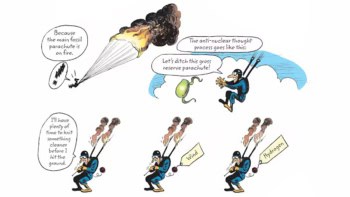With climate change threatening to melt the world’s ice sheets and cause devastating flooding, glaciologists have their work cut out for them, explain Tavi Murray, Ian Rutt and David Vaughan
Planes travelling from Europe to the west coast of the US usually fly directly over Greenland. Most passengers miss it, but if you have a window seat and keep watch at about the time that the dinner trays are being cleared away, then you may be lucky enough to catch a glimpse of a truly majestic landscape in which massive glaciers, fed from a vast and featureless ice sheet, spill into iceberg-choked fjords. Although your plane will be thousands of metres overhead, these remote glaciers are nonetheless feeling the impact of human activities like air travel. As the temperatures over Greenland rise as a result of climate change, the speed at which many of these glaciers are moving is increasing so rapidly that more ice is being lost from the ice sheet than is being replaced by new snowfall. In other words, the ice sheet is giving up its mass to the oceans, and, as a result, sea levels are rising.
The rate of sea-level rise has startled both scientists and policy-makers enough to make headlines and become embedded in government and international reports. It is easy to see why they are concerned — even a half-metre rise would cause flooding that would affect hundreds of millions of people in low-lying areas. Suddenly, “glacier dynamics” — the physics that controls how fast glaciers flow — has become a subject of international importance.
The 2007 report from the Intergovernmental Panel on Climate Change (IPCC) cites retreating glaciers and rising sea levels as evidence that warming of the climate system is unequivocal. And with enough water stored in the Greenland and Antarctic ice sheets to raise global sea levels by approximately 7 m and 57 m, respectively, being able to predict how these large ice sheets will behave in a warming climate is critical if we are fully to understand the consequences of climate change.
In the May issue of Physics World, Tavi Murray, Ian Rutt and David Vaughan describe how physicists can predict the movement and melting of glaciers.
To read the full version of this article — and the rest of the May issue of Physics World — please subscribe to our print edition.



